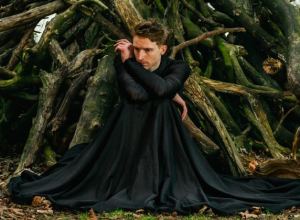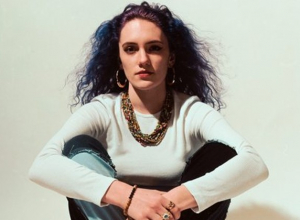For the first time, a boy – Jeremy Sumpter (Frailty) – stars in the title role, opposite Jason Isaacs (The Patriot, Harry Potter and the Chamber of Secrets) as Captain James Hook. The fairies will twinkle and Neverland will fill you with wonder, but don’t drop your guard. The battle between Hook and Pan has never been fought by enemies so evenly matched. The story begins on a chilly night in buttoned-up Edwardian London as Wendy Darling (Rachel Hurd-Wood) mesmerizes her younger brothers with tales of swordplay, swashbuckling and Captain Hook, the legendary pirate who fears nothing but a ticking clock. But a clock is ticking for Wendy, too. Her father has decreed that it’s time for her to grow up. After tonight, no more stories. She’s to be groomed for womanhood and marriage by strict Aunt Millicent (Lynn Redgrave). Unknown to the Darlings, Peter Pan loves Wendy’s stories, too, and travels a great distance to hear them. His appearance in their nursery that night, along with a jealous little fairy called Tinker Bell (Ludivine Sagnier), triggers an awfully big adventure for Wendy and her brothers. Following him out the window like a small flock of birds, the children swoop over London’s moonlit rooftops, through a galaxy of radiant planets and stars, to the magical Neverland, where they begin an exhilarating new life free of grown-up rules with Peter and the Lost Boys in their secret underground home. Confronting depraved pirates, malicious mermaids, a monstrous crocodile and, worst of all, the vicious steel claw dangling from Hook’s right arm, Wendy and her brothers find out what they’re made of. And the ongoing battle between Peter and Hook escalates to a thrilling climax, played out against the fantastical backdrop of the enchanted world of Neverland. The Peter Pan cast contrasts veteran character actors at the peak of their craft with remarkable break-out talent and a number of brand-new discoveries. In addition to Sumpter and Isaacs, the film stars Olivia Williams (The Sixth Sense, Rushmore) as the elegant and empathetic Mrs. Darling, Academy Award® nominee Lynn Redgrave (Gods and Monsters) as socially-minded Aunt Millicent, Richard Briers (The Good Life) as Hook’s sly sidekick Smee and French sensation Ludivine Sagnier (Swimming Pool) as the mischievous fairy Tinker Bell. Rachel Hurd-Wood, discovered at an open casting call in London, makes an assured and impressive screen debut as Wendy. P. J. Hogan co-wrote Peter Pan with Michael Goldenberg (Contact) and was intent on remaining true to the spirit of Barrie’s original work. The film’s producers shared this passion. Lucy Fisher had been trying to make Peter Pan for 20 years and has now made a dream come true with her husband and partner, producer Douglas Wick, their Red Wagon Entertainment, and producer Patrick McCormick. Filming in his native Australia, Hogan collaborated with world-renowned behind-the-scenes artists including cinematographer Donald McAlpine (an Academy Award® nominee for Moulin Rouge), production designer Roger Ford (an Academy Award® nominee for Babe), costume designer Janet Patterson (a three-time Academy Award® nominee for The Piano, Portrait of a Lady and Oscar and Lucinda) and composer James Newton Howard (Oscar®-nominated for five films including My Best Friend’s Wedding). Garth Craven (Legally Blonde, Restoration) and long-time Steven Spielberg collaborator Michael Kahn (a six-time Oscar® nominee and winner for Saving Private Ryan, Schindler’s List and Raiders of the Lost Ark) edited Peter Pan. Industrial Light + Magic’s Scott Farrar (an Oscar® winner for Cocoon and a nominee for A.I. Artificial Intelligence and Backdraft) headed the visual effects team. Mark Forker headed Digital Domain’s team, which also contributed key visual effects, and Clay Pinney was special effects supervisor. Mohamed Al Fayed, Gail Lyon and Jocelyn Moorhouse are the film’s executive producers. Charles Newirth is co-executive producer. About the Production … “ … for children and for those who were once children …” The story of Peter and Wendy’s trip through the night skies is rooted in the collective consciousness like a recurring dream – intoxicating, fantastical, irresistible. Much more than romantic nostalgia or a simple bedtime story, Peter Pan represents our most primal hopes and fears. Its powerful emotional truth springs from a fantasy of flight and adventure that is both universal and timeless. Technologically, the time has never been better to tell this story on screen. Philosophically, the world’s need to dream, imagine and believe, as Peter Pan urges us to do, is greater than ever. Nevertheless, it was a long time coming. The partnership that finally brought Peter Pan to the screen convenes players who have been loyal to the project for many years. Lucy Fisher first procured the film rights 20 years ago and has nurtured the project through development with producing partner Douglas Wick. Sharing a passion for the story, Revolution's Joe Roth and Todd Garner and Columbia's Amy Pascal alchemized the project with P. J. Hogan on-board as director and co-writer. Universal's Stacey Snider, Mary Parent and Scott Stuber completed a team whose energetic and muscular collaboration realized this version of Peter Pan for audiences everywhere. “… when the world of make-believe becomes real …” A beguiling duality ripples through Peter Pan. Are we meant to imagine that the Darling children actually stepped off their window ledge and flew to Neverland one night when their father had been especially stern? Or should we instead assume that Wendy bid her childhood a poignant farewell with a fantastic dream on her last night in the nursery? Either scenario offers audiences an awfully big adventure. With P. J. Hogan at the helm, a calibrated balance between the magic of storytelling and the magic of effects was always the mandate. Set in a world that appears “normal,” his visually lavish film has the romantic tone of a turn-of-the-century painting with fresh, authentic performances and a lively respect for the original material – as well as children who fly, a ticking crocodile the size of a double-decker bus and a fencing duel set in the sails of a pirate ship high above the ground. The contrast between the story’s two worlds – prim Edwardian London and larger-than-life Neverland – is sharply drawn. The city’s gray, cold formality melts from the children’s memories as soon as they breathe in Neverland’s surreal jungles. P. J. Hogan’s openness to magic and imagination, along with his ability to draw others into that special world, were balanced with a scholar’s mastery of J. M. Barrie’s work. “The book is amazing – dense and full of great characters and marvelous moments. You get the feeling that J. M. Barrie put everything that ever occurred to him in it,” Hogan observed. “And the play is so different from what I remembered – the story is strong, filled with adventure and action, and very funny, but also very, very moving. What drew me to making the film was realizing it had not been done. Yes, it’s literally been filmed, but the full story hadn’t been done. There were wonderful things that had not been put on-screen before.” Hogan’s intimacy with the material made the script sing – he rewrote an earlier draft by Michael Goldenberg (Contact) after coming on-board as director. “I think P. J. has the entire play and the book in a sort of mental Palm Pilot that he can draw up anytime,” said actress Olivia Williams, who plays Mrs. Darling. “I don’t think there is a phrase spoken that isn’t somewhere referenced back to Barrie. To have produced something so natural and modern and filmic from a story written 100 years ago is amazing.” Hogan’s knowledge was also a valuable arbiter on-set, guiding the director and his actors during the inevitable moments when something that works on the page doesn’t hold up in performance. “Whenever there was a creaky bit we couldn’t quite get through, P. J. would always go back to the source material,” said Jason Isaacs, who had also immersed himself in writings by and about Barrie to prepare for the twin roles of Mr. Darling and Captain Hook. “What P. J. has done is what Barrie would do today if he had a Hollywood studio at his disposal.” Oscar® nominee Lynn Redgrave plays the Darling family disciplinarian, Aunt Millicent, a character Hogan invented with Redgrave in mind. “Aunt Millicent is not in the original, but she fits right in,” said Redgrave, who saw the play many times as a child in England. “She’s a desperate romantic, and a funny, full character. “P. J. is endlessly inventive,” she continued. “If he were a painter, he’d be inventing new colors that had never existed before. He has been fantastically true to J. M. Barrie while bringing in some original touches that are so Barrie-esque that it would be hard for me to say whether something was in the original or not.” Producer Lucy Fisher shared the devotion to Barrie’s work. “It is a privilege and an honor and a burden to do something that so many people love,” she confessed. “You want to do it justice. “Peter Pan is not just about kids having an adventure and playing with fairies,” Fisher emphasized. “The actual Barrie material, while completely accessible to children, also has a depth and mystery to it, which is why I think it has sustained for so long. The myths that sustain themselves are the ones in which people face fear and come through it. ” For Fisher, the story has always been Wendy’s as much as Peter’s. “The play is called Peter Pan,” she noted, “but the book is called Peter and Wendy because it’s really two stories. Peter is certainly the star but the point of view was always Wendy’s – jumping out the window and coming back in.” The filmmakers all agreed that what happens in between Wendy “jumping out the window and coming back in” had to feel believable for their Peter Pan to make its mark. “One of the great ambitions from the very beginning was to give the audience the pleasure of letting it seem true, letting us all really go to Neverland, letting us inhabit a real version of a fantasy place,” said producer Douglas Wick. “We knew that with today’s technology we could create that kind of strange reality in a way that’s never been possible before. “The emotional reality was the other great challenge – and finding a director who could deliver both,” Wick continued. “Our mission was to avoid any kind of arch version of a moustache-twirling Hook or a silly Peter. We knew P. J. would bring a tone of emotional reality and credibility. His script was very focused on a credible Hook, a credible Mr. Darling and a family that interacted in a recognizable way so that it wouldn’t seem like remote people in a remote place and time.” “ Proud and insolent youth! ” “Peter Pan is this kid who’s free and gets to do anything he wants. He gets to fly, he gets to sword fight, he gets to kill pirates – it’s what every kid wants and Peter Pan has it.” So says Jeremy Sumpter, who ought to know. The young American actor chosen to perform this iconic role is the first boy ever to portray Peter Pan in a major production. Hogan appreciated the opportunity to put a boy on-screen as Peter Pan. “Peter Pan has been a cartoon character, and onstage he’s mainly been played by women,” the director explained. “In the silent film version, he was played by a woman, and in Hook, he was 40 years old. Now a kid is finally getting to do the greatest role ever written for a kid. Jeremy is Peter Pan. He is wild, confident, boisterous, fun – all those things that were so difficult to find in one kid. I was looking for the 12-year-old Errol Flynn, which was very difficult because 12-year-olds usually don’t know who they are, and are not confident. We searched a long time. But I knew as Jeremy walked through the door that he was it.” Jason Isaacs, the versatile British actor who plays Peter Pan’s nemesis, felt the impact of Sumpter’s energy every day. “They can’t hold him still to put the make-up on him in the morning,” Isaacs joked. “He’s a terrible influence on me and the Lost Boys, which is why he’s such a great Peter Pan. He never looks down, he never looks back. He’s like a supernova – you have to try and keep up with him.” Sumpter relished acting out the rivalry between Peter Pan and Hook. “My favorite shot in the whole film is when Peter says, ‘To die would be an awfully big adventure.’ It makes Hook so mad and then – tick tock! – Hook looks back and there’s the crocodile!” But Sumpter understood that Peter Pan isn’t always crowing. “Jeremy has the face of an angel, but also has the face of an animal,” observed producer Lucy Fisher. “He has complete energy, a leadership quality and unbounded personal charisma. Yet he has a tender side, too, so there are scenes where he is hurt or sad, and he is a breathtaking natural actor. He delivers the lines with a naturalness that never sounds stagey. He is fearless and yet has a lot of heartfelt emotion, too.” For his villain, Hogan followed the tradition observed since the very first stage production of Peter Pan nearly a century ago by casting one actor as both Captain Hook and Mr. Darling. It made perfect sense to Jason Isaacs. “Hook’s an incredibly dangerous man. He’s been played for laughs in other versions, but Barrie wrote a book that adults and children can enjoy, and at its center is a frightening character. It’s no surprise that this creature, who represents the scariest things about being grown up, looks a lot like Wendy’s father.” Both of these frightening men are also very fearful themselves. “Mr. Darling is ruled by Aunt Millicent who tells him what everyone will think, how everyone will judge him,” Isaacs explained. “And Hook’s scared that he’ll never fulfill his destiny. He should be ruling the Seven Seas and have the respect of his men, and yet this irritating little boy doesn’t seem to be scared of him.” Isaacs, whose recent work includes roles in Harry Potter and the Chamber of Secrets, The Patriot and Black Hawk Down, was one of the first actors Hogan cast. “It’s a star part,” the director said, “but I didn’t want someone children would be familiar with. I want kids to be afraid of Hook and I think they’ll be afraid of Jason’s portrayal. His Hook is driven, psychotic, charming and capable of anything. “Jason is very versatile,” Hogan continued. “He changes so much from film to film but I think Captain Hook is the role he was born to play. He’s got a great way of combining true menace with charm and wit and that’s a really tough combination.” Isaacs’ transformation into the narcissistic madman required 90 minutes with his hair, make-up and wardrobe team. A carefully coiffed follower of fashion, Hook wears only the finest velvets, silks, leather and jewelry, while his dissolute men cover themselves in stinking rags. His tangle of cascading ringlets, sculpted from virgin Russian human hair, is styled to resemble melting black candles. But his most important accessory is his deadly hook – or rather, hooks, for he keeps a variety on hand. “Our sculptor made a contraption that goes all the way up my arm and tightens with a ratchet,” said Isaacs. “It’s like a torture chamber instrument, very sharp and dangerous.” Second unit director and veteran stunt coordinator Conrad Palmisano said the device resembled “a can opener for 55-gallon drums of fuel. It’s quite vicious-looking when it comes at you and I think seeing Peter Pan stand up to this ferocious enemy with the claw in one hand and a sword in the other will be very exciting.” Hook’s other most prominent appendage is his sidekick Smee, played by the venerable Richard Briers. “Smee and Hook are like an old married couple,” said Isaacs of the ruthless pair. Casting Briers as the sly old rogue was particularly satisfying for Hogan. “I grew up watching Richard Briers on television, on The Good Life in the 1970’s,” the director recalled, “which I think a lot of Australians did, and it was always a dream of mine to work with him. He is one of the funniest, warmest screen presences, and when I was working on the screenplay, I couldn’t imagine anybody better for Smee.” “One girl is worth twenty boys …” The three-continent search for a young actress to portray Wendy was ultimately the filmmakers’ biggest challenge in casting Peter Pan. Hundreds of girls were seen at open calls in the United States, United Kingdom and Australia before Rachel Hurd-Wood, who had never acted before and lives in England’s Home Counties, was found at an open call in London. “Rachel was the last one cast,” said Hogan. “We needed a girl who felt right for the period – a 12-year-old girl with dignity, strength and wit. Kids are different now.” The filmmakers were more concerned with emotional truth than professional credits. Nevertheless, the role of Wendy was technically challenging. “It’s a very difficult part because she has to change during the movie,” Fisher explained. “When we found Peter, we thought, ‘Who is going to be able to look good next to him?’ Then we found this girl who has the same degree of presence as he does, and she pulls off a very complicated part with vigor and elegance.” According to Isaacs, who shared many scenes with Hurd-Wood, her lack of training proved an asset. “Rachel doesn’t have any craft to hide behind,” he noted. “It’s got to be real for her or she can’t do it. That’s why her performance is so truthful.” Hurd-Wood’s trip to Neverland began one day after school when her mother met her at the door with a tape measure. “My grandparents heard about the part on television and told my mum they were searching for a typically English Wendy of this height and that sort of thing. I’d never done any acting. Mum said I wasn’t going for the part but for the fun of seeing what an audition for a film would be like.” After the open call, she was called back to audition on camera, called again to read opposite Isaacs, called a third time to work with an acting coach, and then flown to Australia for a screen test. Next, she spent four days in Los Angeles to see the producers and work with John Kirby, the acting coach for all the children in Peter Pan. Finally, after a long spell of waiting, she learned that she had the part. In the course of filming, she acquired skills she’d never imagined, from fencing to flying, and only complained about one thing. “It’s not fun to cry,” she said. “Your friends from the set can’t talk to you because it will get you distracted from the scene, so it’s hard and tiring and just not fun. One time I spent a whole day crying and the next day I could have broken an arm and wouldn’t have cried because I was just totally drained of all crying.”Laughing or crying, she admired her character. “Wendy’s a really great person,” she said. “She loves adventure, but still has a girly side. If I had lived then, I would have loved to be her friend.” Kids and Animals Although the Peter Pan cast boasts respected actors of excellent pedigree in many key roles, the ranks of the Lost Boys and the young members of the Darling family are filled with newcomers. “The children are fantastic and have an amazing influence on the set,” said Olivia Williams, “because when something spontaneous and childlike happens, there is a wonderful sense of celebration. P. J. has cast kids who aren’t trained to be cute, so all those truthful moments are spontaneous and it’s been a real education to watch them work.” Harry Newell, who plays the Napoleon-obsessed John Darling, explained the special challenges presented by working with Rebel, the St. Bernard who appears as Nana in the film. “It can be quite hard working with a dog,” he observed. “Sometimes you do a perfect take and the dog mucks up, not going on his mark or something, and sometimes the dog would do a perfect take and you wouldn’t. But it was good fun having Rebel around.” Neither Newell nor Freddie Popplewell, who plays little Michael Darling, had acted before. Of the six Lost Boys, only Harry Eden, who plays Nibs, had previous professional experience. Three of the Lost Boys – Theodore Chester, George Mackay and Rupert Simonian – were discovered by a casting agent in one location, the Harrodian School in London. The school’s curriculum and methods encourage creative expression, but possibly more auspicious is the fact that Harrodian’s headmaster is named James Hook. Director of photography Donald McAlpine, who has shot 50 feature films, discovered that working with the kids could result in technical choices that surprised him. “It was a running gag with P. J. and me,” he recalled. “I would select a focal length which is long and takes in a smaller view. Then he would immediately say he wanted the widest angle lens I could get. Those lenses created some immense lighting problems for me, but I’ve generally got to say that he was right. The distortion these lenses create on adults goes unnoticed on these beautiful young children. And on top of that, you see the whole world, so you end up with an extreme close-up and a wide shot – two for the price of one.” Read On... | 







![Luke De-Sciscio talks to us about having the courage to be yourself, forgiving that which is outside of one's control and following whims [EXCLUSIVE] Luke De-Sciscio talks to us about having the courage to be yourself, forgiving that which is outside of one's control and following whims [EXCLUSIVE]](https://images.contactmusic.com/images/home/homepage/luke-de-sciscio-abof-a.jpg)
